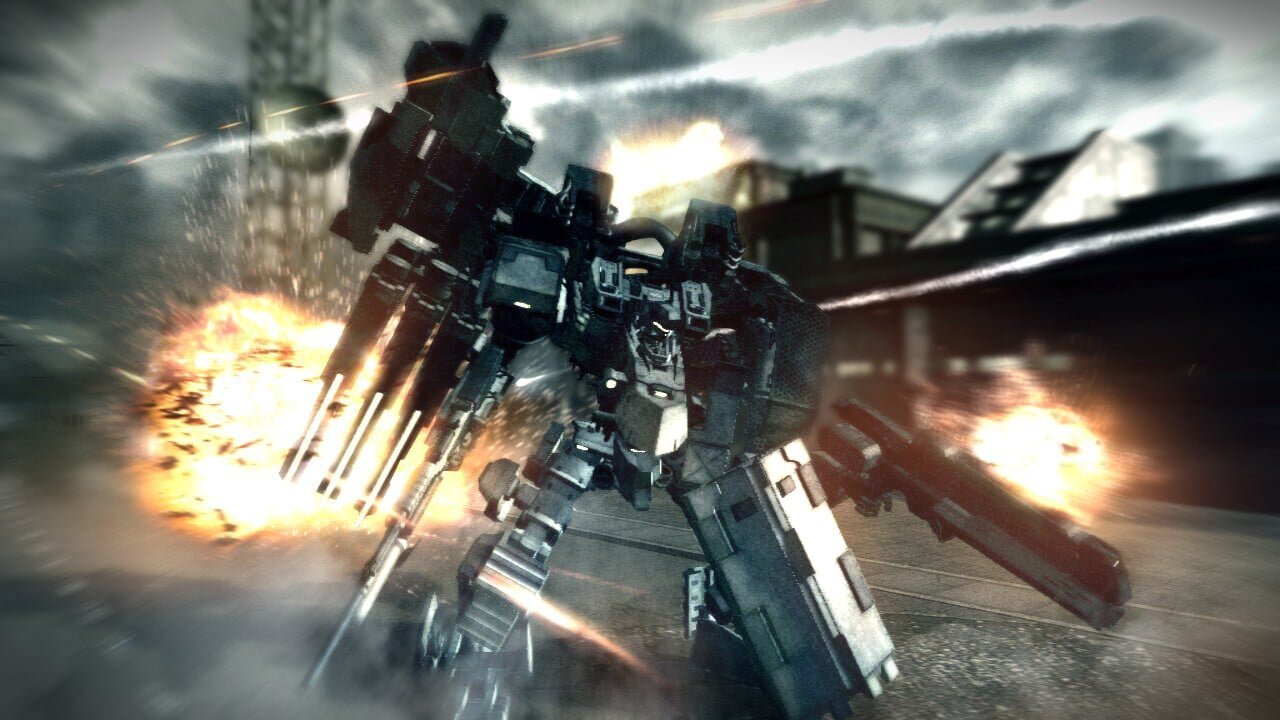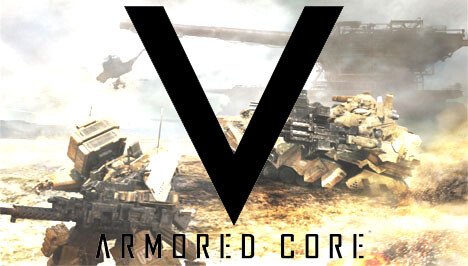Hard Core Armor
It should come as no surprise to anyone that Armored Core V, by From Software, is not an easy game. After all, the Japanese studio has made quite a name for themselves recently with the masochist’s dreams known as Demons Souls and Dark Souls. From Software is a company that prides itself on deep gameplay that demands players don’t just play a game, they learn it, suffer at its difficulty and ultimately experience a certain exhilaration from mastery. Armored Core V is true to that form, but far more reliant on its online component to do that than was expected.
Mechanical Presentation
Unlike the Souls games, Armored Core V isn’t really about fragmented or embedded narratives that ask the player to construct the story for themselves. The tale of a revolutionary war and corporate meddling is unimportant and largely incoherent thanks to poorly translated—and badly paced—dialog, but for people that are keeping score, it’s another face full of the Deus Ex/Syndicate cautionary tale that mega-companies can be bad. The story isn`t really the highlight of the game anyway since this is primarily a game of team-based multiplayer combat.
Once you start getting into the technical side of things, the first impression the graphics leave are that they are unimpressive. This doesn’t need to be a great looking game, and it isn’t. The giant mecha nature of the concept means players spend a lot of time looking at boxy constructs, often running around in city streets and other man-made facilities, and From Software didn’t really go all out to visually sell the idea that these are huge, hulking battle robots towering over trees and people, both of which are noticeably absent. Lighting and particle effects aren’t particularly impressive either, but the no frills approach the game has taken to its graphics means that it’s refreshingly stable in the performance department. The sound quality is decent, but not outstanding. The English voice dubbing in particular seems like a throwback to the 90s when close-to-literal translations meant for awkward phrasing of sentences that probably could have benefited from editing to sound less clunky. The music is an eclectic mix of orchestral compositions and the obligatory wailing guitar, that needs to squeal with the intensity of the mech combat raging. In many ways, the overall presentation of Armored Core V is workmanlike. There’s not the same sense of restrained inspiration that tinged the art and audio direction of the Souls games, but where AC5 may lack frills in aesthetics, it makes up for it in actual mechanics.
Not So Giant Robots
The first, most noticeable thing about Armored Core is the focus. This is a game that’s firmly oriented in multiplayer requiring you to either join or create your own team. Once you do, you find yourself in world where your chosen team is one of many that are now competing for the control of territories against other players. It’s actually a well thought out, solidly designed aspect of the game, but unfortunately it comes at the expense of what has previously been the series’ main strength, a good single player campaign. The incoherent story and repetitive nature of the single player component shows all the earmarks of a hurriedly produced element that felt obligatory to the team when they’d rather be working on the multiplayer. All the basic mechanics of the traditional Armored Core experience are there, but they haven’t really been tweaked to feel like an integral part of a progressing story campaign. Missions tend to blur into the same repetitive search-and-destroy types without much variation in enemies or tactics. Multiplayer, on the other hand, is so integrated into the experience the game feels crippled if you’re not playing it online. The multiplayer even includes a strategic “operator” mode where one player has a complete strategic view of the theater of war, assigning radar targets and being the overall tactician of the team, assuming the other team members trust the operator enough to follow assigned objectives. Players fight for territory, taking it away from other teams, and deploying their own defenses to prevent the same thing from happening to them. This mix of team based multiplayer and traditional “competitive” multiplayer in which players actually go head to head, creates a substantial, lengthy multiplayer experience with a lot of depth. Compared to the tepid single player, there’s a wild imbalance in how From Software decided to organize their resources. The other big change lies with the robots themselves. The Armored Cores—or ACs—of this long running franchise have gotten a bit a reduction. The smaller size of these combat mechs—from 10 meters to about half that in some cases—changes the action of the game somewhat. Rather than being roughly equivalent to the size of most of the buildings around you, these smaller ACs can now use the buildings for cover, making for a comparatively more nimble style of combat for those that prefer mobility over tank & blast combat.
What hasn’t changed is the complexity of the game. Like the Souls games that came before it, players who are used to being coddled with extensive tutorials and a lot of handholding before the difficulty scales up are in for a rude shock. Armored Core V gives players some extremely basic introductory tutorials about navigation and combat, but leaves rest—notably the intricate customization system—almost entirely untouched. Players will have to learn how to buy, equip and judge which components are best for their preferred gameplay by themselves. Like other From Software games, and like past AC games, Armored Core V is only as rewarding as the education you are willing to give yourself in its intricacies. For many gamers, this whole idea of committing to learning the nuances of an extremely in-depth system is both inconvenient and outdated. For a few gamers however, this is an incredibly rewarding system that yields a lot of satisfaction in the ability, sense of progression and tangible increase in skillful gameplay that commitment entails. Couple this with the robust multiplayer and you have a very good—if wildly imbalanced—mech combat title that has no patience for those unwilling to learn, and almost grudgingly sports a lacklustre single player component, in favor of a deep, engaging, complex and merciless multiplayer experience.
This is not a well-balanced game. Players looking for “traditional” AC experience are in for a disappointment. Players new to the AC universe had better take a deep breath and be willing to learn and practice. Mech combat aficionados who have been looking for an in-depth, team based game with subtlety, sophistication and a true appreciation for strategy and skill have quite possibly found their game of the year. This is not a game for everyone, and it’s not even necessarily a game for traditional fans of the series, but for that particular niche audience that game is clearly targeting, this is a must have game.





